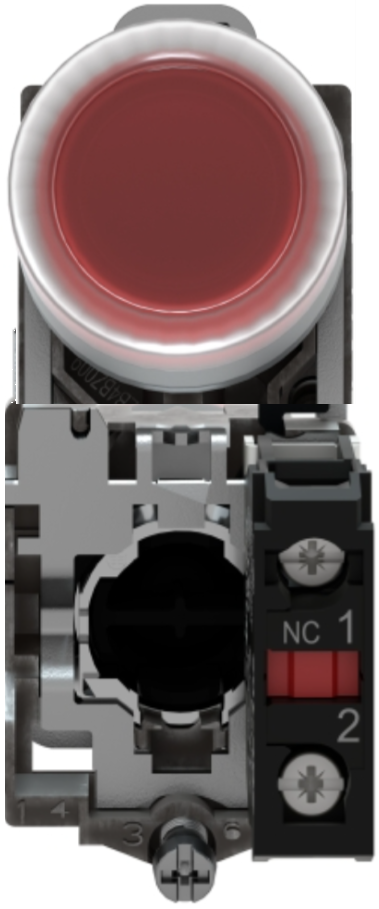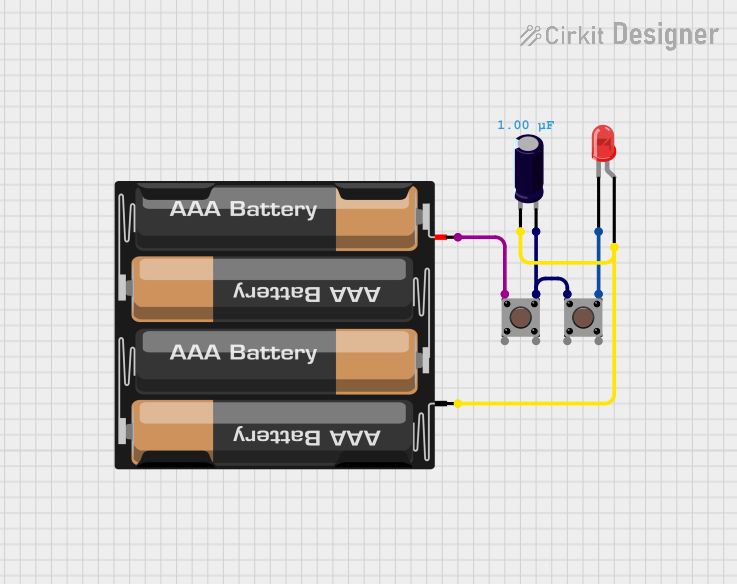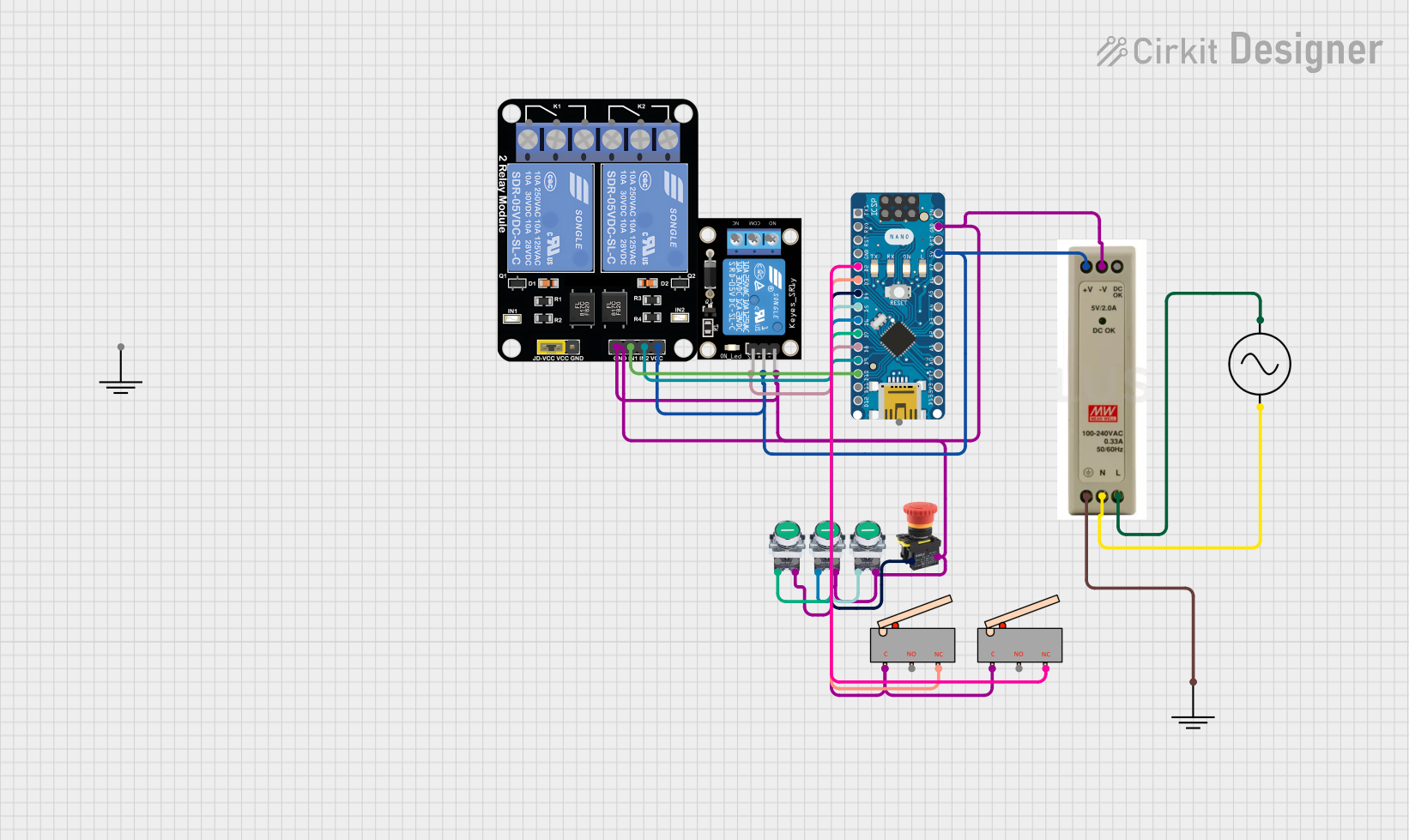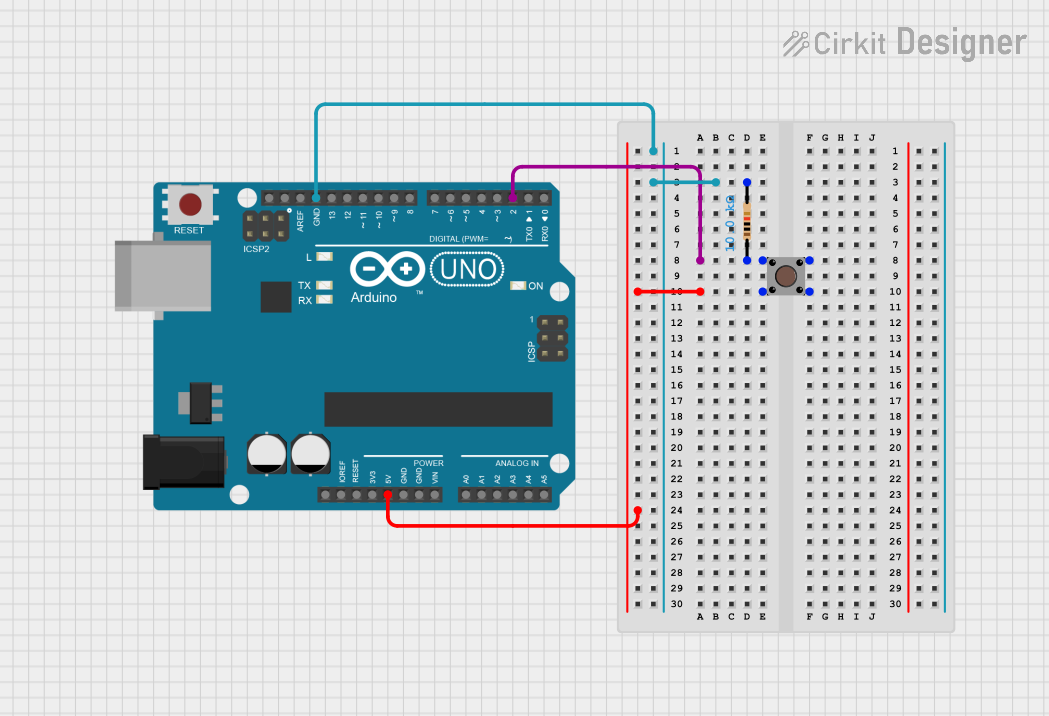
How to Use PUSH BUTTON - STOP: Examples, Pinouts, and Specs

 Design with PUSH BUTTON - STOP in Cirkit Designer
Design with PUSH BUTTON - STOP in Cirkit DesignerIntroduction
The Schneider XB4-BP42 is a high-quality, industrial-grade momentary push button switch designed to interrupt a circuit when pressed. It is commonly used as a "STOP" button in control panels, machinery, and safety systems. This component is ideal for applications requiring reliable and immediate circuit interruption to halt processes or operations.
Explore Projects Built with PUSH BUTTON - STOP

 Open Project in Cirkit Designer
Open Project in Cirkit Designer
 Open Project in Cirkit Designer
Open Project in Cirkit Designer
 Open Project in Cirkit Designer
Open Project in Cirkit Designer
 Open Project in Cirkit Designer
Open Project in Cirkit DesignerExplore Projects Built with PUSH BUTTON - STOP

 Open Project in Cirkit Designer
Open Project in Cirkit Designer
 Open Project in Cirkit Designer
Open Project in Cirkit Designer
 Open Project in Cirkit Designer
Open Project in Cirkit Designer
 Open Project in Cirkit Designer
Open Project in Cirkit DesignerCommon Applications and Use Cases
- Emergency stop buttons in industrial machinery
- Control panels for automation systems
- Safety circuits in manufacturing environments
- Operator-controlled stop mechanisms in electronic devices
Technical Specifications
The following table outlines the key technical details of the Schneider XB4-BP42 push button:
| Parameter | Value |
|---|---|
| Manufacturer | Schneider Electric |
| Part Number | XB4-BP42 |
| Type | Momentary Push Button (STOP) |
| Contact Configuration | 1 Normally Closed (NC) |
| Rated Voltage | 24V to 240V AC/DC |
| Rated Current | 10A (AC), 6A (DC) |
| Actuator Type | Red, Round, Flush |
| Mounting Hole Diameter | 22mm |
| Mechanical Durability | 1,000,000 operations |
| Electrical Durability | 500,000 operations |
| Operating Temperature | -25°C to +70°C |
| Degree of Protection | IP66, IP67, IP69K |
| Standards Compliance | IEC 60947-5-1, UL 508, CSA C22.2 |
Pin Configuration and Descriptions
The XB4-BP42 has a simple pin configuration, as shown below:
| Pin | Description |
|---|---|
| NC | Normally Closed contact (default) |
| COM | Common terminal for the circuit |
Usage Instructions
How to Use the Component in a Circuit
Mounting the Push Button:
- Drill a 22mm hole in the control panel or mounting surface.
- Insert the push button into the hole and secure it using the provided locking ring.
Wiring the Push Button:
- Connect the COM terminal to the power source or control circuit.
- Connect the NC terminal to the load or device to be controlled.
- Ensure all connections are secure and insulated to prevent short circuits.
Operation:
- When the button is not pressed, the circuit remains closed, allowing current to flow.
- Pressing the button opens the circuit, interrupting the current and stopping the connected device or process.
Important Considerations and Best Practices
- Ensure the push button is rated for the voltage and current of your application.
- Use appropriate wire gauges and connectors to handle the rated current.
- Avoid exposing the push button to extreme environmental conditions beyond its rated specifications.
- Regularly inspect the button for wear and tear, especially in high-use applications.
- For safety-critical applications, integrate the push button into a fail-safe circuit design.
Example: Connecting to an Arduino UNO
The XB4-BP42 can be used with an Arduino UNO to detect when the button is pressed. Below is an example circuit and code:
Circuit Diagram
- Connect the COM terminal to the Arduino's GND pin.
- Connect the NC terminal to a digital input pin (e.g., D2) on the Arduino.
- Use a pull-up resistor (10kΩ) between the digital input pin and VCC (5V).
Arduino Code
// Define the pin connected to the push button
const int buttonPin = 2; // Digital pin 2 for the push button
int buttonState = 0; // Variable to store the button state
void setup() {
pinMode(buttonPin, INPUT_PULLUP); // Set pin as input with internal pull-up resistor
Serial.begin(9600); // Initialize serial communication
}
void loop() {
buttonState = digitalRead(buttonPin); // Read the state of the button
if (buttonState == LOW) { // Button pressed (NC contact opens, pin reads LOW)
Serial.println("STOP button pressed!");
} else {
Serial.println("STOP button not pressed.");
}
delay(200); // Small delay to debounce the button
}
Troubleshooting and FAQs
Common Issues and Solutions
| Issue | Possible Cause | Solution |
|---|---|---|
| Button does not stop the circuit | Incorrect wiring or loose connections | Verify wiring and ensure secure connections. |
| Button feels stuck or unresponsive | Mechanical wear or debris in the actuator | Inspect and clean the button; replace if necessary. |
| Arduino does not detect button press | Incorrect pin configuration or pull-up issue | Check wiring and ensure pull-up resistor is used. |
| Button fails in high-current applications | Exceeding rated current or voltage | Use a relay or contactor for high-power loads. |
FAQs
Can the XB4-BP42 be used outdoors?
- Yes, the push button is rated IP66, IP67, and IP69K, making it suitable for outdoor and harsh environments.
What is the difference between NC and NO contacts?
- NC (Normally Closed) contacts are closed by default and open when the button is pressed. NO (Normally Open) contacts are open by default and close when the button is pressed. The XB4-BP42 uses NC contacts.
Can I use this push button with a 12V DC circuit?
- Yes, the XB4-BP42 supports a wide voltage range, including 12V DC.
How do I replace a damaged push button?
- Disconnect the power supply, remove the locking ring, and replace the button with a new XB4-BP42. Reconnect the wiring and secure the button in place.
By following this documentation, users can effectively integrate the Schneider XB4-BP42 push button into their projects and ensure reliable operation.